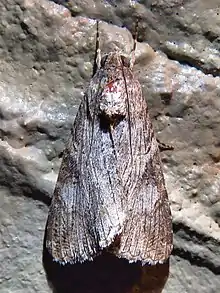Melipotis acontioides
Melipotis acontioides, the royal poinciana moth, is a species of moth in the family Erebidae. It was first described by Achille Guenée in 1852. The species is found from the southern United States (including California, Arizona, New Mexico, Texas and Florida)[1] through Mexico and Central America to Brazil, Argentina and the Galápagos Islands. It is also found in the Caribbean, including Cuba and the British Virgin Islands,[2] Jamaica and Puerto Rico.
| Melipotis acontioides | |
|---|---|
 | |
| Scientific classification | |
| Domain: | Eukaryota |
| Kingdom: | Animalia |
| Phylum: | Arthropoda |
| Class: | Insecta |
| Order: | Lepidoptera |
| Superfamily: | Noctuoidea |
| Family: | Erebidae |
| Genus: | Melipotis |
| Species: | M. acontioides |
| Binomial name | |
| Melipotis acontioides (Guenée, 1852) | |
| Synonyms | |
| |
The wingspan is about 43 mm.[3] The forewings are brown gray with dark brown spots. The hindwings are mostly white with a brown blotch towards the edge. Adults are on wing nearly year round.
The larvae feed on Delonix regia and Parkinsonia aculeata[4] and Parkinsonia florida. The larvae feed at night. During the day, they hide in debris at the soil surface near the base of the tree. Pupation also takes place on the ground.
Subspecies
- Melipotis acontioides acontioides
- Melipotis acontioides producta Hayes, 1975 (Galápagos Islands)
References
- "930881.00 – 8610 – Melipotis acontioides – Royal Poinciana Moth – (Guenée, 1852)". North American Moth Photographers Group. Mississippi State University. Retrieved December 2, 2018.
- Becker, Vitor O. (2002). "The Noctuoidea (Lepidoptera) from Cuba described by Herrich-Schäffer and Gundlach in the Gundlach Collection, Havana" (PDF). Revista Brasileira de Zoologia. 19 (2): 349–391. doi:10.1590/S0101-81752002000200006. Archived (PDF) from the original on April 29, 2013.
- Roberts, Jason D. (July 14, 2018). "Species Melipotis acontioides - Royal Poinciana Moth - Hodges#8610". BugGuide. Retrieved December 2, 2018.
- Savela, Markku. "Melipotis acontioides (Guenée, 1852)". Lepidoptera and Some Other Life Forms. Retrieved December 2, 2018.